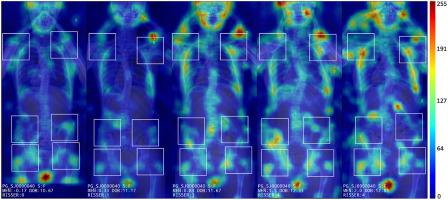Computers in Biology and Medicine ( IF 7.7 ) Pub Date : 2021-07-23 , DOI: 10.1016/j.compbiomed.2021.104681 Eddie Magnide 1 , Georges Wona Tchaha 1 , Julie Joncas 2 , Christian Bellefleur 2 , Soraya Barchi 2 , Marjolaine Roy-Beaudry 2 , Stefan Parent 3 , Guy Grimard 3 , Hubert Labelle 3 , Luc Duong 1

|
Adolescent Idiopathic Scoliosis (AIS) is a deformation of the spine and it is routinely diagnosed using posteroanterior and lateral radiographs. The Risser sign used in skeletal maturity assessment is commonly accepted in AIS patient's management. However, the Risser sign is subject to inter-observer variability and it relies mainly on the observation of ossification on the iliac crests. This study proposes a new machine-learning-based approach for Risser sign skeletal maturity assessment using EOS radiographs. Regions of interest including right and left humeral heads; left and right femoral heads; and pelvis are extracted from the radiographs. First, a total of 24 image features is extracted from EOS radiographs using a ResNet101-type convolutional neural network (CNN), pre-trained from the ImageNet database. Then, a support vector machine (SVM) algorithm is used for the final Risser sign classification. The experimental results demonstrate an overall accuracy of 84%, 78%, and 80% respectively for iliac crests, humeral heads, and femoral heads. Class activation maps using Grad-CAM were also investigated to understand the features of our model. In conclusion, our machine learning approach is promising to incorporate a large number of image features for different regions of interest to improve Risser grading for skeletal maturity. Automatic classification could contribute to the management of AIS patients.
中文翻译:

青少年特发性脊柱侧弯 EOS 片的自动骨成熟度分级
青少年特发性脊柱侧弯 (AIS) 是脊柱变形,通常使用后前位和侧位 X 光片进行诊断。骨骼成熟度评估中使用的 Risser 征在 AIS 患者的管理中被普遍接受。然而,Risser 征受观察者间差异的影响,它主要依赖于对髂嵴骨化的观察。这项研究提出了一种新的基于机器学习的方法,用于使用 EOS 射线照片进行 Risser 标志骨骼成熟度评估。感兴趣的区域包括左右肱骨头;左右股骨头;和骨盆是从射线照片中提取的。首先,使用从 ImageNet 数据库预训练的 ResNet101 型卷积神经网络 (CNN) 从 EOS 射线照片中提取总共 24 个图像特征。然后,支持向量机 (SVM) 算法用于最终的 Risser 符号分类。实验结果表明,髂嵴、肱骨头和股骨头的总体准确率分别为 84%、78% 和 80%。还研究了使用 Grad-CAM 的类激活图以了解我们模型的特征。总之,我们的机器学习方法有望为不同的感兴趣区域整合大量图像特征,以改善骨骼成熟度的 Risser 分级。自动分类有助于 AIS 患者的管理。还研究了使用 Grad-CAM 的类激活图以了解我们模型的特征。总之,我们的机器学习方法有望为不同的感兴趣区域整合大量图像特征,以改善骨骼成熟度的 Risser 分级。自动分类有助于 AIS 患者的管理。还研究了使用 Grad-CAM 的类激活图以了解我们模型的特征。总之,我们的机器学习方法有望为不同的感兴趣区域整合大量图像特征,以改善骨骼成熟度的 Risser 分级。自动分类有助于 AIS 患者的管理。


























 京公网安备 11010802027423号
京公网安备 11010802027423号